Stephen W. Hiemstra's Blog, page 198
October 19, 2018
Preface to Living in Christ
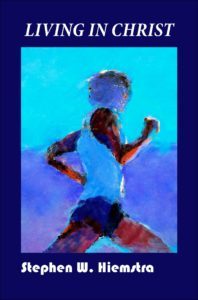
“Do you not know that in a race all the runners run,
but only one receives the prize?
So run that you may obtain it.” (1 Cor 9:24)
By Stephen W. Hiemstra
The Christian walk begins with spiritual rebirth (John 3:3). On the Day of Pentecost with the founding of the church, the Apostle Peter described rebirth in these terms: “Repent and be baptized every one of you in the name of Jesus Christ for the forgiveness of your sins, and you will receive the gift of the Holy Spirit.” (Acts 2:38) The Apostle Paul describes this rebirth differently, saying: “…if you confess with your mouth that Jesus is Lord and believe in your heart that God raised him from the dead, you will be saved.” (Rom 10:9) Rebirth is a lifelong transition that starts with repentance, baptism, belief in the resurrection of Christ—our living role model—and proceeds under the mentorship of the Holy Spirit.
Character
Every journey has a destination. As in the Parable of the Talents, Christians live in anticipation of Christ’s return and to hear the words: “Well done, good and faithful servant. You have been faithful over a little; I will set you over much. Enter into the joy of your master.” (Matt 25:21) Success in this context requires that we use our talents to advance God’s Kingdom to the extent we are able. Christian ethics requires modeling ourselves after Christ, striving to undertake our duty to advance the Kingdom, and living in the hope of Christ’s return in glory. In Christ, we live joyfully knowing who we serve and how the story ends.
Community
Although the tendency in our time is to interpret the Gospel as individuals, we live in a community modeled after a Triune God—Father, Son, and Holy Spirit—who live in perfect, eternal harmony. We are never alone in coming to faith, working out our gifts as we prosper in faith, and living in anticipation of Christ’s return. Being created in the image of a perfect and holy God, God himself models in Christ what it means to be good, be emotionally secure, and judge rightly. Our hearts and minds are wholly integrated and because we live in a community that values integration, we strive together to perfect our characters and our talents respecting spiritual boundaries provided by God himself.
Leadership
Part of our own maturation process is learning to live responsibly in community and to offer leadership in our families and the community of faith, and within society, regardless of our talents and roles. Christian leadership is rooted in humility which leaves room in our personal and corporate lives for God’s intervention. For this reason, inner strength, not physical strength, exemplifies the Christian leader because self-confident people are the ones willing to take up the wash-basin and follow Christ (John 13:3-15).
Four Philosophical Questions
The ethics question is one of four questions typically posed in philosophy that must be addressed by any serious spirituality. These questions are:
1.Metaphysics—who is God?
2.Anthropology—who are we?
3.Epistemology—how do we know?
4.Ethics—what do we do about it? (Kreeft 2007, 6)
As an author, my first two books—A Christian Guide to Spirituality and Life in Tension—address the metaphysical question and my third book—Called Along the Way—explores the anthropological question in the first person. My fourth book, Simple Faith, examined the epistemological question. In this book, I explore the ethics question writing not as one with specialized training in philosophy but as one cognizant of the need, both as a Christian and an author interested in Christian spirituality, to have a reasonable answer to the question—how do we act out our faith, especially knowing that we are created in the image of God?
Christian Perspective
In examining the ethics question, I focus on ethics from a Christian perspective. Here I will not try to justify Christian ethics so much as explain them. At a time and in a place where people scoff at developing a theological understanding of their faith and refuse to teach Christian morality, ethics is almost a lost art in the church. At the heart of the ethical dilemma is the problem that theological principles are in tension with one another and always have been, something that is so obvious that it cannot be overlooked and requires serious discernment. For example, how do you love a sinner who refuses to confess their sin and forces you to pay their consequences? How do you practice forgiveness? Ethics training may not answer the question, but it will help you frame it appropriately for further reflection and future action.
Spirituality is Lived Theology
Ethics is never devoid of a context for acting out our faith, be it character formation within our own lives, being mentored within the community of faith, or learning to assume leadership. It is therefore useful to review case studies of each of these contexts both in scripture and in our present circumstances. If our spirituality is lived theology, then it is informed by our theology and, in turn, informs our theological reflection.
References
Kreeft, Peter. 2007. The Philosophy of Jesus. South Bend, IN: Saint Augustine Press.
Preface to Living in Christ
Also see:
A Roadmap of Simple Faith
Christian Spirituality
Looking Back
A Place for Authoritative Prayer
Other ways to engage online:
Author site: http://www.StephenWHiemstra.net, Publisher site: http://www.T2Pneuma.com.
Newsletter: http://bit.ly/2018_Lead
The post Preface to Living in Christ appeared first on T2Pneuma.net.
October 16, 2018
Dewey Educates Thought
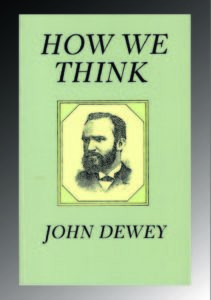 John Dewey. 1997. How We Think (Orig Pub 1910). Mineola: Dover Publications.
John Dewey. 1997. How We Think (Orig Pub 1910). Mineola: Dover Publications.
Review by Stephen W. Hiemstra
Some books we find on our own; others come recommended by people that we trust. In this case, one of my mentors, Professor Glenn Johnson, argued in class in the 1980s that the scientific method needs to be amended to include a felt needprior to problem definition, based on arguments by John Dewey. In my own research, I have also observed that the single most difficult step in the scientific method was the movement from a felt need to a definition of the problem. Thus, between Glenn’s instruction and my own experience, I have always referred to Dewey and Johnson together when discussing the scientific method.
Introduction
In the preface to his book, How We Think, John Dewey expresses his objective in these words:
“… this book also represents the conviction that such is not the case [scientific think is irrelevant to teaching]; that the native and unspoiled attitude of childhood, marked by ardent curiosity, fertile imagination, and the love of experimental inquiry, is near, very near, to the attitude of the scientific mind.”(vii)
Dewey believes that classrooms are full of little scientists! This is a remarkable statement coming from one of America’s most influential educators in 1910 because public education in the nineteenth century was but one step removed from the Sunday school programs where education began in the churches.
Organization
Dewey breaks his argument up into three parts:
“The Problem of Training Thought
Logical Considerations and
The Training of Thought”(ix)
He then writes five chapters in support of each part. I will organize the remainder of this review around these three parts.
The Problem of Training Thought
When Dewey talks about thought, his focus is on reflective thought, writing:
“Active, persistent, and careful consideration of any belief or supposed form of knowledge in the light of the grounds that support it, and the further conclusions to which it tends, constitutes reflective thought.”(6)
This focus on reflective thought is interesting because Dewey uses it to educate students into employing the scientific method in their thinking. He writes:
“While it is not the business of education to prove every statement made, any more than to teach every possible item of information, it is its business to cultivate deep-seated and effective habits of discriminating tested beliefs from mere assertions, guesses, and opinions; to develop a lively, sincere, and open-minded preference for conclusions that are properly grounded, and to ingrain into the individual’s working habits methods of inquiry and reasoning appropriate to the various problems that present themselves.”(27-28)
Dewey’s diagnosis of the problem of teaching is also interesting because he focuses on the student’s habits of the mind (or cognitive preferences). He writes:
“The teacher’s problem is thus twofold. On the one side, he needs (as we saw in the last chapter) to be a student of individual traits and habits; on the other side, he needs to be a student of the conditions that modify for better or worse the directions in which individual powers habitually express themselves.”(46)
Observing learning habits allows the teacher both to steer students towards their lessons in ways that they more easily understand and to improve their efficiency in learning. Either way Dewey appears to anticipate the importance of personality types as articulated by Carl Jung (1955) and later developed more fully by Myers-Briggs (1995).
Logical Considerations
Dewey’s interest in felt needs, which Johnson later incorporated into the scientific method, arose from his inquiry into the nature of reflection. He writes:
“Upon examination, each instance reveals, more or less clearly, five logically distinct steps: (i) a felt difficulty; (ii) its location and definition; (iii) suggestion of possible solution; (iv) development by reasoning of the bearings of the suggestion; (v) further observation and experiment leading to its acceptance or rejection; that is, the conclusion of belief or disbelief.”(72)
This informal process of reflection, which results in belief or unbelief, would naturally align with how we might also come to faith.
One distinction that has stuck with me is the distinction between analysis and synthesis: Dewey writes:
“As analysis is conceived to be a sort of picking to pieces, so synthesis is thought to be a sort of physical piecing together; and so imagined, it also becomes a mystery.”(114)
A review is a type of analysis while a sermon is more of a synthesis, even though it may have analysis of scripture as part of the argument. In this sense, Dewey sees science as more of a synthesis when he writes:
“… science consists in grouping facts so that general laws or conclusions may be drawn from them.”(127)
This statement may have been heavily influenced by zoology, where different animals are classified into kingdoms, phylum’s, classes, orders, families, geniuses and species.
The Training of Thought
Dewey starts his discussion of education with a child who is first occupied with mastering his own body (157), then moves into learning to play and manipulate signs that have representative meaning (161). Interestingly, Dewey writes:
“Gestures, pictures, monuments, visual images, finger movements—any consciously employed as a sign is logically language.”(170-171)
He goes on to observe:
“Learning, in the proper sense, is not learning things, but the meaning of things, and this process involves the use of signs, or languages in its generic sense.”(176)
Dewey sees three motivations for focusing on language:
“The primary motive for language is to influence (through the expression of desire, emotion, and thought) the activity of others; its secondary use is to enter into more intimate sociable relations with them; its employment as a conscious vehicle of thought and knowledge is a tertiary, and relatively late, formation.”(179)
Seminary training opened up entirely new avenues of thought for me—I suddenly had words to express ideas that previously had been unformed. Sometimes you hear people talk about the meaninglessness of “churchy” words—suddenly, the churchy words made perfect sense to me. This is what Dewey refers to as the formative nature of language.
Assessment
John Dewey’s book, How We Think, is an educational classic and has been described as a work in philosophy. I started this book in 2006 and set it aside until this past month because it was a bit challenging. You may also find it challenging, but notwithstanding worth the effort.
References
Johnson, Glenn L. 1986. Research Methodology for Economists: Philosophy and Practice. New York: MacMillan Publishing Company.
Jung, Carl J. 1955. Modern Man in Search of a Soul(Orig. Pub. 1933). New York: Harcourt Inc.
Myers, Isabel Briggs and Peter B. Myers. 1995. Gifts Differing: Understanding Personality Type(Orig Pub 1980). Mountain View: Davies-Black Publishing.
Dewey Educates Thought
Also see:
Books, Films, and Ministry
Other ways to engage online:
Author site: http://www.StephenWHiemstra.net, Publisher site: http://www.T2Pneuma.com.
Newsletter: http://bit.ly/2018_Lead
The post Dewey Educates Thought appeared first on T2Pneuma.net.
October 15, 2018
Monday Monologues: A Better Story, October 15, 2018 (podcast)
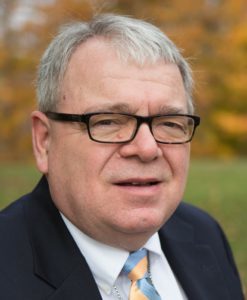 Stephen W. Hiemstra, 2017
Stephen W. Hiemstra, 2017By Stephen W. Hiemstra
In today’s podcast, I pray for faith and talk about a Better Story.
After listening, please click here to take a brief listener survey (10 questions).
To listen, click on the link below.
https://t2pneuma.net/wp-content/uploads/2018/10/Monday_monologue_Better_Story_10152018.mp3
Hear the words; Walk the steps; Experience the joy!
Monday Monologues: A Better Story, October 15, 2018 (podcast)
Also see:
Monday Monologue On March 26, 2018
Other ways to engage online:
Author site: http://www.StephenWHiemstra.net, Publisher site: http://www.T2Pneuma.com.
Newsletter: http://bit.ly/2018_Lead
The post Monday Monologues: A Better Story, October 15, 2018 (podcast) appeared first on T2Pneuma.net.
October 14, 2018
Prayer of Faith
 By Stephen W. Hiemstra
By Stephen W. Hiemstra
Merciful father:
All praise, honor, and glory are yours,
Lord who cares for me–
for my mind is clouded and
my heart betrays me,
but you are ever with me, for me, and uplifting me
even when I am lost and alone,
not even knowing what to confess.
Thank you for your presence
amidst the storms of daily life and
the torments of spirits that would consume me.
Of all the things that I have experienced
you are the most immediate, most real
and I thank you for it.
In the power of your Holy Spirit,
grant me now a full measure of faith
that I might remember my baptism and your resurrection
all the days of my life and
ever confess that you are Lord of my life and
all that is, was, or will ever be.
In Jesus’ precious name, Amen.
Prayer of Faith
Also see:
Books, Films, and Ministry
Other ways to engage online:
Author site: http://www.StephenWHiemstra.net, Publisher site: http://www.T2Pneuma.com.
Newsletter: http://bit.ly/2018_Lead
The post Prayer of Faith appeared first on T2Pneuma.net.
October 12, 2018
The Better Story
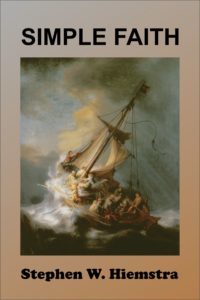 By Stephen W. Hiemstra
By Stephen W. Hiemstra
How do we know what we know is true?
The end of the modern era spells the end of the modern pretension that we can logically prove that objective truth is knowable and provable. It is not. Because it is not knowable and provable in the abstract, proof requires that truth be knowable and provable to a human audience. An argument must both make sense and feel right in the context of the human condition. In the context of a confusing and dangerous world, who has the best story, one that you can bet your life on?
The Gospel Story
The Gospel story is the story of Jesus’ birth, life and ministry, death, and resurrection. This story is the focus of the four Gospels—Matthew, Mark, Luke, and John—in the New Testament and of faith statements, like the Apostle’s Creed.
Christianity began in a graveyard with the resurrection. The resurrection could not have occurred without Jesus’ crucifixion and death which was, in turn, associated with his life and ministry. Because Jesus’ life and ministry was chronicled looking back from the resurrection, each sentence in the New Testament should be prefaced with these words: Jesus rose from the dead, therefore . . . Jesus’ life, ministry, suffering, death, and resurrection are the Gospel story.
Christians, like Mary Magdalene, are the ones running from the cemetery to tell the rest of the world that Jesus lives (Matt 28:8).
After the Gospels themselves, the story of Jesus is the subject of many New Testament sermons by both Peter (Acts 2:14–41; 10:34–43) and Paul (Acts 13:16–41).
Context for the Gospel
In Genesis 11:1-9 we read the story of how men schemed to build a tower up to heaven to force God to come down and bless their city. The God who created heaven and earth (Gen 1:1) looked down on this effort and just laughed. These devious and obviously stupid men thought that they could manipulate a god that stood outside of time and space having created both. To prevent further foolishness, God confused them with different languages so that they would not be able to scheme together any further.
Because God transcends the material world and time itself, no physical or metaphysical tower can reach up to heaven.Towers, temples, religions, philosophies, and sciences are all equally vain. God must come down to us; we cannot reach up to him. The story of God’s efforts to reach down to us is recorded in scripture; he himself came down in the person of Jesus of Nazareth (Matt 1; Luke 1). God reversed the curse of Babel on the day of Pentecost with the giving of his Holy Spirit and the founding of the church (Acts 2), the oldest, continuous institution known to humanity.
But this story is not over; the church is not a museum of the past. Jesus points to the future and promises to reunite with his disciples:
“And if I go and prepare a place for you, I will come again and will take you to myself, that where I am you may be also.” (John 14:3)
Because the future is in Christ and we worship a loving and all powerful God, we know that our future is secure. In the midst of the traumas and tribulations of life, our hope is assured.
The Better Story
Also see:
A Roadmap of Simple Faith
Christian Spirituality
Looking Back
A Place for Authoritative Prayer
Other ways to engage online:
Author site: http://www.StephenWHiemstra.net, Publisher site: http://www.T2Pneuma.com.
Newsletter: http://bit.ly/2018_Lead
The post The Better Story appeared first on T2Pneuma.net.
October 9, 2018
Hauerwas and Willimon: Christians as Colonists, Part 2
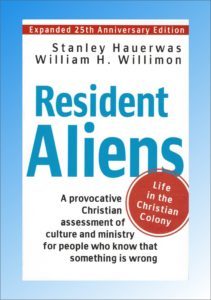 Stanley Hauerwas and William H. Willimon. 2014. Resident Aliens: A Provocative Christian Assessment of Culture and Ministry for People Who Know that Something is Wrong (Orig pub 1989). Nashville: Abingdon Press. (Goto Part 1)
Stanley Hauerwas and William H. Willimon. 2014. Resident Aliens: A Provocative Christian Assessment of Culture and Ministry for People Who Know that Something is Wrong (Orig pub 1989). Nashville: Abingdon Press. (Goto Part 1)
Review by Stephen W. Hiemstra
Fundamental to the problem of the postmodern church is grasping for how much society has changed. In Christendom, a sense of right and wrong permeated the entire culture—even those that never entered a church shared Christian morality even if reluctantly. An important problem in postmodern culture is its fragmentation—kids frequently introduce themselves by who they listen to and prefer communication with friends, not in person, but by texting. One gets the impression that for a boomer a FB friend is an acquaintance, but for a millennial a FB friend is a intimate—in part because of differences in the personal details shared online.
Introduction
In their book, Resident Aliens, Stanley Hauerwas and William H. Willimon (hereafter H&W) described the church already in 1989 as:
“The church exists today as resident aliens, an adventurous colony in a society of unbelief…Western culture is devoid of a sense of journey, of adventure, because it lacks belief in much more than the cultivation of an ever-shrinking horizon of self-preservation and self-expression.”(49)
My wife and I had our first child in 1989 right after I received my first job in finance and could afford for the first time the house that we lived in and we attended a church plant in our community that now is a well-established church. We were among the fortunate few because anyone without a post graduate degree still earns probably little more than they did back then.
Church in the Lurch
Churches not serving the fortunate few were already struggling back in the 1980s and have lost members, especially young people, ever since. H&W observe:
“An army succeeds, not through trench warfare but through movement, penetration, tactics.(54)
The old saying goes, the best defense is a good offense, yet most churches never learned to play offense because in Christendom evangelism consisted primarily in keeping those that showed up on Sunday morning. If no one shows up, they are lost as to what to do.
The Importance of Story
The church played defense pretty much throughout the modern era. In attempting to respond to the unscientific nature of faith, churches used abstract concepts, like “God is love”, to communicate the Gospel, but for the most part such abstractions merely served to vaccinate people against real Christianity. Conceptual—ersatz or cultural— Christianity is sterile and cannot reproduce itself.
H&W write:
“How does God deal with human fear, confusion, and paralysis? God tells a story: I am none other than the God who ‘brought you out of the land of Egypt, out of the house of bondage.’ (Deut 5:6)”(54)
At its heart, the Gospel is the story of Jesus, not the concept of Jesus! We cannot understand and appreciate the Gospel unless we follow Jesus and participate in his story. (55) For postmoderns, it’s all about narrative and the Good News is that the church has the best story around—if it is willing and able to tell it.
Assessment
In part one of this review, I have outlined a few key points and summarized the book. In part two, I will endeavor to engage their arguments in more depth.
In Resident AliensStanley Hauerwas and William H. Willimon outline an approach to a post-Constantine church from perspective of the church and Christian ethics. The text is engaging and is often cited as a follow up to John Howard Joder’s The Politics of Jesus(Grand Rapids: Eerdmans, 1972), which they frequently cite.
Footnotes
https://divinity.duke.edu/faculty/directory. @Stanleymemelord
Hauerwas and Willimon: Christians as Colonists, Part 2
Also see:
Books, Films, and Ministry
Other ways to engage online:
Author site: http://www.StephenWHiemstra.net, Publisher site: http://www.T2Pneuma.com.
Newsletter: http://bit.ly/2018_Lead
The post Hauerwas and Willimon: Christians as Colonists, Part 2 appeared first on T2Pneuma.net.
October 8, 2018
Monday Monologues: Postmodernism, October 8, 2018 (podcast)
 Stephen W. Hiemstra, 2017
Stephen W. Hiemstra, 2017By Stephen W. Hiemstra
In today’s podcast, I prayer for traveling mercies and talk about Postmodernism.
After listening, please click here to take a brief listener survey (10 questions).
To listen, click on the link below.
https://t2pneuma.net/wp-content/uploads/2018/09/Monday_monologue_postmodernism_10082018.mp3
Hear the words; Walk the steps; Experience the joy!
Monday Monologues: Postmodernism, October 8, 2018 (podcast)
Also see:
Monday Monologue On March 26, 2018
Other ways to engage online:
Author site: http://www.StephenWHiemstra.net, Publisher site: http://www.T2Pneuma.com.
Newsletter: http://bit.ly/2018_Lead
The post Monday Monologues: Postmodernism, October 8, 2018 (podcast) appeared first on T2Pneuma.net.
October 7, 2018
Prayer for Traveling Mercies
 By Stephen W. Hiemstra
By Stephen W. Hiemstra
Merciful Father,
All praise and honor be yours,
for you are a God of the journey–
one that walks with us on life’s long march.
You never tire of the pace or complain of the company,
yet we do constantly–forgive our impatience,
our boredom when the slope is steep and
the weather most challenging.
We give thanks for your cheerful companionship and
constant encouragement,
especially when we are undeserving and bad company.
In the power of your Holy Spirit,
remember those afflicted by hurricanes and fires and poor health and
offer us traveling mercies that we might enjoy a restful journey and
return home safely.
In Jesus’ precious name, Amen.
Prayer for Traveling Mercies
Also see:
Books, Films, and Ministry
Other ways to engage online:
Author site: http://www.StephenWHiemstra.net, Publisher site: http://www.T2Pneuma.com.
Newsletter: http://bit.ly/2018_Lead
The post Prayer for Traveling Mercies appeared first on T2Pneuma.net.
October 5, 2018
Postmodernism
 By Stephen W. Hiemstra
By Stephen W. Hiemstra
In his book, Who’s Afraid of Postmodernism, James Smith (2006, 26) Describes post modernism as a kind of pluriform and variegated phenomena, an historical period after (post) modernism, heavily influenced by French philosophers, especially Jacques Derrida, Jean-François Lyotard, and Michael Foucault. Adding to the confusion, Smith observes that postmodernism does not make a clean break with modernism, but tends to intensify certain aspects of modernism, particularly notions of freedom (Smith 2006, 19-21, 26).
Smith starts with the intriguing premise that the basic ideas of these three postmodern philosophers have misunderstood. When properly understood, postmodern philosophy and the traditional teaching of the church remain compatible. The collapse of the church in our lifetime can accordingly be seen to lay the groundwork for a revitalization of the church around traditional teaching—once purged of its modernistic thought patterns (Smith 2006, 22-23, 29). This re-imaged traditional teaching he refers to as radical orthodoxy and has an incarnation focus which takes time, place, and space seriously and which affirms both the liturgy and the arts (Smith 2006, 127).
Jacques Derrida
Smith’s premise that these philosophers have been misunderstood because of weak bumper-sticker summaries of them. For example, Derrida’s misunderstood statement is: “there is nothing outside the text.” (Smith 2006, 36) The idea that one can simply read a text, particularly an ancient text written in another language, and understand its meaning is to misunderstand the role of language, context, and interpretation.
While often said to mean that the Bible cannot be read and understood by just anyone, Smith says that this is not what Derrida is saying. Derrida’s point is simply that all understanding of texts requires interpretation—the context and the interpretative community—which implies that there is no such thing as
objective truth. Interpretation is always required (Smith 2006, 38-40, 43).
Jean-François Lyotard
Smith also sees Lyotard’s idea of a meta-narrative as misunderstood in its bumper-sticker characterization. Postmodern critics have trouble with the meta-narrative or big story of scripture—creation, fall, redemption, and eschatology. Smith disputes, however, that the scope of meta-narratives is Lyotard’s main concern. Smith sees Lyotard’s main concern being the truth claims of modern use of meta-narratives—science is itself a meta-narrative but falsely and deceptively claims to be universal, objective, and demonstrable through reason alone. Smith writes: “For the postmodern, every scientist is a believer.” Lyotard is perfectly okay with the idea of faith preceding reason, following Augustine (Smith 2006, 62-72) and Anselm, who cites Isaiah 7:9.[1]
Michael Foucault
Foucault’s concern about institutional power structures is hard to reduce to a bumper-sticker characterization, in part, because he resists reductionism in his writing style and focuses on tediously pure description. Smith sees Foucault preoccupied with disciplinary structures, but wonders what his real intentions are. He talks about two readings of Foucault: Foucault as Nietzschean and Foucault as a closet enlightenment liberal (Smith 2006, 96-99). Smith (2006, 102) writes:
“What is wrong with all these disciplinary structures is not that they are bent on forming or molding human beings into something, but rather what they are aiming for in that process.”
Smith sees Foucault offering three lessons to the church: to see “how pervasive disciplinary formation is within our culture”; to identify which of these disciplines are “fundamentally inconsistent with…the message of the church”; and to “enact countermeasures, counter disciplines that will form us into the kinds of people that God calls us to be” (Smith 2006, 105-106).
Weakness in Modern Witness
Smith sees hope in the Derrida’s critique because the modern understanding of the Christian message is itself a distortion of traditional church teaching. In attempting to frame the Christian message in ahistorical truth statements (God is love), the narrative tradition (God showed his love by sovereignly granting the exodus of the nation of Israel from Egypt) has been lost. Because the Christian message is contextual in biblical accounts and is interpreted by the church, it meets Derrida’s primary concerns. Consequently, according to Smith, the church must, however, abandon modern stance and language in order to thrive in the postmodern environment (Smith 2006, 54-58).
When exactly did the church relinquish its internal discipline and why?[2] Smith (2006, 107) sees communion, confession, foot washing, and economic redistribution as the kind of disciplines that need to be maintained. A more normal reading of discipline might ask why the teaching of the church—church doctrine—is ignored and no dire consequences follow for those most engaged in the ignoring.
References
Davies, Brian and G.R. Evans [ed}. 2008. Anselm of Canterbury: The Major Works. Oxford World Classics. New York: Oxford University Press.
Longfield, Bradley J. 1991. The Presbyterian Controversy: Fundamentalists, Modernists, and Moderates. New York: Oxford University Press.
Smith, James K.A. 2006. Who’s Afraid of Postmodernism: Taking Derrida, Lyotard, and Foucault to Church. Grand Rapids: Baker Academic.
Footnotes
[1] In his Proslogion, Anselm writes: “I believe so that I may understand.” (Davies and Evans 2008, 87)
[2] Longfield (1991, 79-91) chronicles changes 1925-1936 in the Presbyterian Church from dropping the five fundamental of faith as ordination requirements in 1925 to changes at Princeton Theological Seminary serving to allow theological diversity within the denomination. These changes also effectively removed doctrinal basis for church discipline, accept in the case of gross error.
Postmodernism
Also see:
A Roadmap of Simple Faith
Christian Spirituality
Looking Back
A Place for Authoritative Prayer
Other ways to engage online:
Author site: http://www.StephenWHiemstra.net, Publisher site: http://www.T2Pneuma.com.
Newsletter: http://bit.ly/2018_Lead
The post Postmodernism appeared first on T2Pneuma.net.
October 2, 2018
Hauerwas and Willimon: Christians as Colonists, Part 1
 Stanley Hauerwas and William H. Willimon.2014. Resident Aliens: A Provocative Christian Assessment of Culture and Ministry for People Who Know that Something is Wrong. Nashville: Abingdon Press. (After October 9 Goto Part 2)
Stanley Hauerwas and William H. Willimon.2014. Resident Aliens: A Provocative Christian Assessment of Culture and Ministry for People Who Know that Something is Wrong. Nashville: Abingdon Press. (After October 9 Goto Part 2)
Review by Stephen W. Hiemstra
My kids have a hard time understanding first that today’s culture differs dramatically from the postwar culture that I knew growing up and that people actually enjoyed life back then. Life mostly revolved around family and church. Almost no one had psychological problems, although we all knew about battle fatigue, alcoholism, and suicide. Virtually everyone wanted the American dream and expected to participate in it. What we did not know what how fragile the economic assumptions were that allowed the American Dream to be a reality.
Introduction
In their book, Resident Aliens, Stanley Hauerwas and William H. Willimon (H&W) date the end of Christendom to 1963 when the blue laws in Greenville, South Carolina changed to allow the Fox Theater to open on Sunday (15). H&W have no interest in bemoaning or explaining the passing of Christendom and the American Dream, but rather focus on articulating what it means for the Christian church to delink itself from the cultural assimilation that began with Emperor Constantine’s Edict of Milan in AD 313 (17).
The Task of the Church
In other words, while I might bemoan the task of supporting and raising kids in a period of downward mobility when neither the church nor the schools have my back, H&W focus on the how the church can articulate more fully its biblical mandate in a postmodern context. Unlike the modern church, which strived to explain the Bible to modern people in modern terms, they write:
“In Jesus we meet not a presentation of basic ideas about God, world, and humanity [in support of Christendom], but an invitation to join up, to become part of a movement, a people.”(21)
Our task in the church is not to transform the Gospel for the world, but first to transform ourselves by being faithful to the Gospel (22). It is the world, not the Gospel, that is being transformed.
The Challenge
The need to abandon Christendom could not be greater, as H&W write:
“If Caesar can get Christians there to swallow the ‘Ultimate Solution’ [a la Adolf Hitler] and Christians here [in America] to embrace the [use of the atomic] bomb, there is no limit to what we will not do for the modern world [and compromise our basic Christian values].”(27)
Buying into Christendom may mean Sabbath rest on Sundays while businesses are closed, but at what cost?
The Church
H&W see the church as fundamentally a political organization that allows the Christian to interpret the world for what it is. (38). They write:
“Witness without compromise leads to worldly hostility. The cross is not a sign of the church’s quiet, suffering submission to the powers-that-be, but rather the church’s revolutionary participation in the victory of Christ over those powers.”(47)
Not being willing to remain silent in the face of evil is in every generation a political decision. To do so as a group project is inherently political.
Organization
H&W are on the faculty of Duke Divinity School in Durham, NC. Hauerwas is the Gilbert T. Rowe Professor Emeritus of Divinity and Lawand
Willimon is a Professor of the Practice of Christian Ministry. They write in seven chapters:
“The Modern World: On Learning to Ask the Right Questions
Christian Politics in the New World
Salvation as Adventure
Life in the Colony: The Church as Basis for Christian Ethics
Ordinary People: Christian Ethics
Parish Ministry as Adventure: Learning to Enjoy Truth Telling
Power and Truth: Virtues that Make Ministry Possible”(ix-x)
These chapters are proceeded by a foreword and Preface, and followed by an Afterword and index.
Assessment
In part one of this review, I have outlined a few key points and summarized the book. In part two, I will endeavor to engage their arguments in more depth.
In Resident AliensStanley Hauerwas and William H. Willimon outline an approach to a post-Constantine church from perspective of the church and Christian ethics. The text is engaging and is often cited as a follow up to John Howard Joder’s The Politics of Jesus (Grand Rapids: Eerdmans, 1972), which they frequently cite.
Footnotes
https://divinity.duke.edu/faculty/directory. @Stanleymemelord
Hauerwas and Willimon: Christians as Colonists, Part 1
Also see:
Books, Films, and Ministry
Other ways to engage online:
Author site: http://www.StephenWHiemstra.net, Publisher site: http://www.T2Pneuma.com.
Newsletter: http://bit.ly/2018_Lead
The post Hauerwas and Willimon: Christians as Colonists, Part 1 appeared first on T2Pneuma.net.



